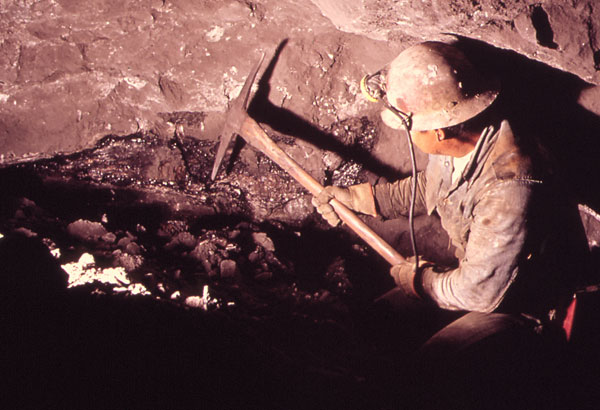Commentary: Bias of banning open pit mining

The open pit method, regardless of the mineral to be extracted, will obviously pose the same environmental threat. File photo
Just days before Gina Lopez’s appointment as environment secretary was formally rejected by the Commission on Appointments, she issued a ban on open pit mining through Department of Environment and Natural Resources Administrative Order (DAO) No. 2017-10. Officially, the subject of the DAO is “Banning the Open Pit Method of Mining for Copper, Gold, Silver, and Complex Ores in the Country.”
On October 24, current Environment Secretary Roy Cimatu announced that the Mining Industry Coordinating Council (MICC) decided to overturn DAO 2017-10 by a majority vote. While Secretary Cimatu said that the decision of the MICC will still be taken up in Cabinet meeting, he sees the formal lifting of the ban before the year ends. Of course, Lopez disagreed with the decision of the MICC and has vowed to do everything she can to maintain the ban.
From an environmental management standpoint, the decision of the MICC to overrule DAO 2017-10 makes sense. From the title alone, one can already question the means employed in supposedly protecting the environment. At first glance, banning an entire activity constitutes an extreme management tool for protecting the environment.
The DAO 2017-10 ban raises more questions. If the open pit method really destroys the environment, why does the ban only apply to some minerals and not others? Why has the DENR resorted to an extreme form of regulation but still limited the open pit method to a few minerals?
The clauses of DAO 2017-10 should have provided the rationale for limiting the ban. Instead, the order mentions a different aspect of mining in justifying the regulation, to wit:
Whereas, the history of mining in the country shows that most, if not all, open pits have ended up as perpetual liabilities, causing adverse impacts to the environment, particularly due to the generation of acidic and/or heavy metal-laden water, erosion of mine waste dumps and/or vulnerability of tailings dams to geological hazards.
DAO 2017-10 goes on to claim that: “records attest that most of the mining disasters in the country were due to tailings spills associated with open pit mining.”
Rather than justify limiting the scope of the open pit ban, the DAO instead identifies mine tailings as a culprit for environmental degradation. This explanation exposes the regulation to another fallacy. Simply put, are tailings spills not also associated with mine tunneling or the other methods of mining? Certainly, the general consequence for pursuing this policy is the crippling of a legitimate industry without effectively confronting both the issue of open pit mining and tailings management.
Furthermore, in making the distinction, the DAO describes the open pit method as:
Whereas, the open pit method of mining, characterized by the extraction of metallic ores from a surface excavation resembling roughly an inverted cone with benches along its walls has been employed in the Philippine mining industry mainly for the extraction and disposition of copper, gold, silver and complex ores.
From the DAO’s definition, there is already an admission that the open pit method is not exclusively used for the extraction of copper, gold, silver and complex ores, as it is just “mainly” used by the country’s mining industry to extract these minerals.
DAO 2017-10 then concludes that open pits will continually be a liability thereby justifying the ban:
Whereas, notwithstanding the provisions of the Mining Act on final mine rehabilitation and decommissioning, the fact remains that the rehabilitation of mined-out open pits shall invariably require perpetual maintenance works that shall outlive the existence of mining companies and, thereby, leave to the unknown the fate of the environment.
From the foregoing, there are serious questions why the ban is discriminating against mines extracting copper, gold, silver and complex ores. The open pit method, regardless of the mineral to be extracted, will obviously pose the same environmental threat. One such exclusion from this ban is quarrying of cement materials, which technically should fall under the category of open pit mining. Clearly, the supposed exigency for implementing a ban has no leg to stand on because open pit mining is still allowed for other minerals.
So, without any reasonable justification for limiting the ban to the extraction of a few minerals, let alone any strong reason why there should be a ban on the open pit method of mining in the first place, DAO 2017-10 is a dubious environmental management policy. With this regulation, legitimate mines will be forced to shut down, and illegal ones to proliferate. After all, who can stop mining in this country?
After issuing another order to formally repeal DAO 2017-10, it will do good if the DENR takes a step back to reassess its strategy in regulating the mining industry pursuant to its mandate to protect the environment and responsibly manage our natural resources. Maybe, there will be a realization that the Mining Act, the Clean Air Act, the Clean Water Act, the Philippine Environmental Impact Statement System and even the Indigenous Peoples’ Rights Act, along with the other environmental laws and regulations, are already there to sufficiently protect the environment. What needs a further push and improvement is in how these are implemented.
Lawyer Lysander Castillo is an environment fellow at the Stratbase-ADR Institute and the secretary-general of Philippine Business for Environmental Stewardship, or PBEST.
- Latest
























